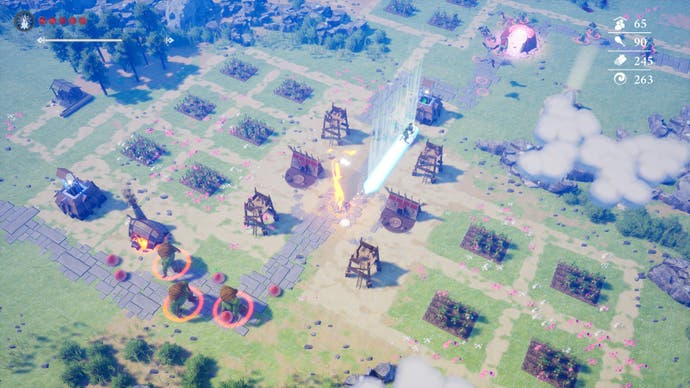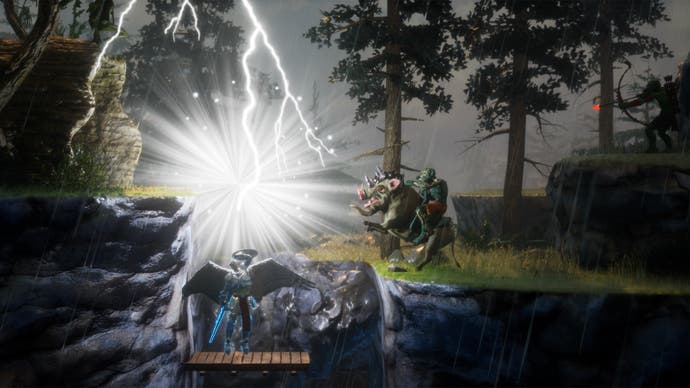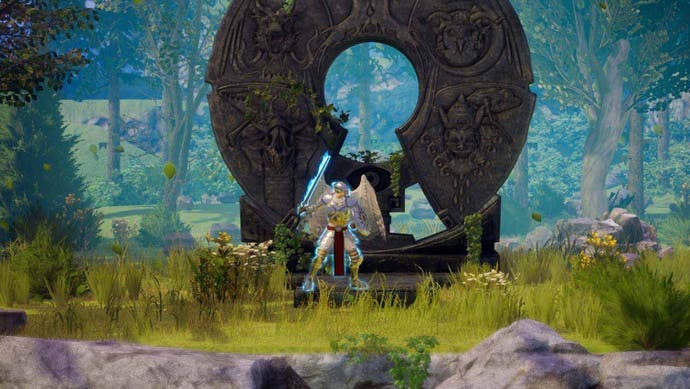SolSeraph review - God on a bit of a budget
Spiritual successor.
In action, how like an angel, in apprehension how like a god. This is handy. In SolSeraph, you play a sort of blend of an angel and a god, as far as I can tell. You have wings and armour and a sword, but you can also inspire people, make the land fertile and cast lightning at your enemies. You're pretty swish, in other words, but then you land and a spider will dangle from above and hurt you, and then you'll step in some brambles. Ouch.
SolSeraph is a spiritual successor to ActRaiser, and ActRaiser was really, really interesting. You were a god in ActRaiser and you lead your people. Sometimes you wandered around side-scrolling bits sticking it to baddies. Sometimes you flew over a map encouraging your people to build towns and roads and to seal evil-doers away for good. It was such a harmonious blend: beat-'em-up and god game. A bit of a classic. And SolSeraph stays pretty close to the original design.
So once again you divide your time between wandering around 2D platforming levels and fighting monsters, and then taking to the skies and leading your own people as they get their civilisations back in order, building a town, fighting off waves of enemies and then smashing up a local baddie god for good measure. Let's look at this second part of the game first, because I had a fair amount of fun with it, and that's because SolSeraph has taken ActRaiser's god game stuff and turned it into a tower defence number.

At the heart of your village is the campfire. This is the thing you must protect and keep burning, while incoming mobs march along various stone paths towards it, each one who reaches the flames doing a single point of damage to you until the fire eventually goes out for good.
To stop that from happening you build defensive structures like barracks and archer towers and magic towers and spikes that line the paths the mobs come down. To afford all that you need to get an actual town going, so you build houses, which create the people you need to man your defences, you chop wood from nearby forests, you build farms and all that sort of jazz. It's simple stuff but very clearly laid out on radial menus and it's fun to chug along with most of the time.
Ultimately, in between fighting off waves, you're looking to grow your town to the point where you can track back along the individual paths the mobs are coming from and build a temple right next to their lair. This will clear the air around the lair and allow you to go in and kick everyone around in a 2D side-scrolling section. Do this enough and you open up each area's boss god. Sort them out and you get to move on and do the whole thing again in a different landscape with slightly different challenges.
It's entertaining enough. Wave-based tower defence is always money in the bank, and SolSeraph is pleasantly forgiving a lot of the time if you want to just race on and blitz the final boss. This is because, while your defences are protecting your campfire, you can also swan around the map as the god/angel you are and lay on direct attacks and even conjure mobs of your own to fight. You regain the mana you need to do this by swooping through clouds, which is weirdly satisfying, and even though you don't have that many attacks, just as you don't have that many building types to play with, there is something nice about even the most rudimentary kind of strategy game when the rules are as simple as they are here and you always know what you're doing wrong. (Generally what I'm doing wrong is running low on timber.)

The 2D sections are a bit more of a bother, alternating between kill-everything missions in small areas and longer treks, in which you march up a tree, say, to finish off the tree god at the top. The problem isn't so much the lack of variety in enemies - each area introduces a few new ones, but they still fall pretty neatly into the sorts of things you've seen many times before. It's more that the whole thing is a bit too roughly hewn. Movement is slightly too heavy, double-jumping can be a bit of a pain, and it simply never feels very good to hit someone with your sword, zap them or smack them with an arrow or block something with a shield.
What's most weird about all this is that SolSeraph is the work of ACE Team, the Chilean outfit whose games are generally marked by a glorious unforced strangeness. SolSeraph is not very strange at all, despite an enemy I'm quite fond of who looks like a ball of tomato juice. It plays things straight, and while the result is a likable enough homage to a 16-bit classic, a bit of genuine character might have been enough to elevate a game that sometimes feels like it didn't have the budget to be allowed to become the best version of itself.
I've enjoyed SolSeraph, but I've loved most of ACE Team's other stuff. This is a pleasant tribute act, but I miss the studio's flair for the unforgettable.









